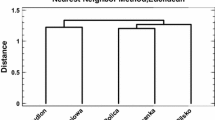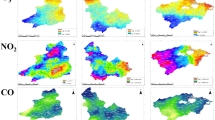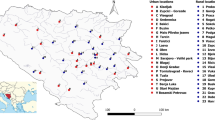Abstract
Using an organism living in situ for monitoring is referred as passive monitoring. Lepraria lobificans Nyl., a leprose lichen growing naturally on monuments and buildings in the city Mandav in central India is used for passive monitoring of atmospheric metals. Seven metals (Cd, Cr, Ni, Al, Fe, Cu, and Zn) were analyzed. Samples collected from road site exhibit the maximum concentration of Fe, Cd, Cr, Ni, and Zn. Iron exhibit maximum accumulation both in lichen thallus and the substratum with mean values of 2,195.63 μg g − 1 dry weight. As compared with other growth form of lichens, L. lobificans exhibits the higher accumulation of Fe than foliose and fruticose lichens. On the basis of these results, it can be hypothesized that L. lobificans is an excellent accumulator of different metals. The statistical analysis applied to the element concentration between the metals as well as between the sites by analysis of variance found the difference to be significant at 1% and 5%, respectively. Student–Newman–Keuls test also shows significant difference for iron between the different metals.
Similar content being viewed by others
References
Alstrup, V., & Hansen, E. S. (1977). Three species of lichens tolerant of high concentration of copper. Oikos, 16, 290–293. doi:10.2307/3543616.
Bajpai, R., Upreti, D. K., & Mishra, S. K. (2004). Pollution monitoring with the help of lichen transplant technique (LTT) at some residential sites of Lucknow. Journal of Environmental Biology, 25(2), 191–195.
Bajpai, R., Upreti, D. K., & Dwivedi, S. K. (2009). Arsenic accumulation in lichens of Mandav monuments, Dhar district, Madhya Pradesh. Environmental Monitoring Assess. doi:10.1007/s10661-008-0641-7.
Baptista, M. S., Teresa, M., Vasconcelos, S. D., Carbral, J. P., Freitas, C. M., & Pacheo, A. M. G. (2008). Copper, Nickel, lead in lichens & tree bark transplants over different period of time. Environmental Pollution, 151, 408–413. doi:10.1016/j.envpol.2007.06.004.
Bergamaschi, L., Rizzio, E., Giaveri, G., Profumo, A., Loppi, S., & Gallorini, M. (2004). Deptermination of baseline element composition of lichens using samples from high elevations. Chemosphere, 55, 933–939. doi:10.1016/j.chemosphere.2003.12.010.
Carreras, H. A., & Pignata, M. L. (2002). Biomonitoring of heavy metals and air quality in Còrdoba City, Argentina, using transplanted lichens. Environmental Pollution, 117, 77–87. doi:10.1016/S0269-7491(01)00164-6.
Christensen, E. R., & Guinn, V. (1979). Zinc from automobile tires in urban runoff. ASCE Environmental Engineering Division Journal, 105, 165–168.
Conti, M. E., & Cecchetti, G. (2001). Bilogical monitoring: Lichens as bioindicators of air pollution assessment—a review. Environmental Pollution, 114, 471–492. doi:10.1016/S0269-7491(00)00224-4.
Crespo, A., & Bueno, A. G. (1982). Flora y vegetatión liquénicas de la Casa de Campo de Madrid (España). Lazaroa, 4, 327–356.
Crespo, A., Divakar, P. K., Arguello, A., Gasca, C., & Hawksworth, D. L. (2004). Molecular studies on Punctelia species of the Iberian Peninsula, with an emphasis on specimens newly colonizing Madrid. Lichenologist (London, England), 36(5), 299–308. doi:10.1017/S0024282904014434.
Dockery, D. W., & Pope, C. A. (1994). Acute respiratory effects of particulate air pollution. Annual Review of Public Health, 15, 107–132. doi:10.1146/annurev.pu.15.050194.000543.
Dubey, A. N., Pandey, V., Upreti, D. K., & Singh, J. (1999). Accumulation of lead in lichens growing in and around Faizabad City, U.P. Journal of Environmental Biology, 20(3), 223–225.
Garty, J. (2001). Biomonitoring atmospheric heavy metals with lichens: Theory and application. Critical Reviews in Plant Sciences, 20(4), 309–371. doi:10.1016/S0735-2689(01)80040-X.
Garty, J., & Ammann, K. (1987). The amount of Ni, Zn, Pb, Cu, Fe and Mn in some lichens growing in Switzerland. Environmental and Experimental Botany, 27, 127–138. doi:10.1016/0098-8472(87)90063-3.
Garty, J., & Delarea, J. (1991). Localization of iron and other elements in the lichen Nephroma articum (L.) Torss. Environmental and Experimental Botany, 31, 367–375. doi:10.1016/0098-8472(91)90062-S.
Garty, J., Galun, M., & Kessel, M. (1979). Localization of heavy metals and other elements caaumulated in the lichen thallus. The New Phytologist, 82, 159–168. doi:10.1111/j.1469-8137.1979.tb07571.x.
Gilbert, O. L. (1968). Biological estimation of air pollution. In Common Wealth Mycological Institute (Ed.), Plant pathologist’s pocket book (pp. 206–207). Kew: Commonwealth Mycological Institute.
Godinho, R. M., Wolterbeek, H. T., Verburg, T., & Freitas, M. C. (2008). Bioaccumulation behavior of lichen Flavoparmelia caperata in relation to total deposition at a polluted location in Portugal. Environmental Pollution, 151, 318–325. doi:10.1016/j.envpol.2007.06.034.
Hawksworth, D. L., & McManus, P. M. (1989). Lichen recolonization on Londan under conditions of rapidly falling sulphur dioxide level, and the concept of zone skipping. Botanical Journal of the Linnean Society, 100, 99–109. doi:10.1111/j.1095-8339.1989.tb01712.x.
Jeran, Z., Jacimovic, R., Batic, F., & Mavsar, R. (2002). Lichens as intrigating air pollution monitors. Environmental Pollution, 120, 107–113. doi:10.1016/S0269-7491(02)00133-1.
Loppi, S., & Bonini, I. (2000). Lichens and mosses as biomonitors of trace elements in areas with thermal springs and fumarole activity (Mt. Amianta, central Italy). Chemosphere, 41, 1333–1136. doi:10.1016/S0045-6535(00)00026-6.
Monaci, F., & Bargagli, R. (1997). Barium and other trace metals as indicators of vehicular emissions. Water, Air, and Soil Pollution, 100, 89–98. doi:10.1023/A:1018318427017.
Nayaka, S., Upreti, D. K., Gadgil, M., & Pandey, V. (2003). Distribution pattern and heavy metal accumulation in lichen of Banglore City with reference to Lalbagh Garden. Current Science, 84(5), 674–680.
Nieboer, E., Ahmed, H. M., Puckett, K. J., & Richardson, D. H. S. (1972). Heavy metal content of lichens in relation to distance from a nickel smelter in Sudbury, Ontario. Lichenologist (London, England), 5, 292–304. doi:10.1017/S0024282972000301.
Nimis, P. L., Castello, M., & Pertotti, M. (1990). Lichens as biomonitors of sulphur di oxide pollution in La Spezia (north Italy). Lichenologist (London, England), 22, 333–344. doi:10.1017/S0024282990000378.
Nriagu, J. O., & Pacyana, J. (1988). Quantitative assessment of worldwide contamination of air, water and soil by trace metals. Nature, 333, 134–139. doi:10.1038/333134a0.
Pilegaard, K. (1979). Heavy metals in bilk Precipitation and transplanted Hypogymnia physodes and Dicranweisia cirrata in the vicinity of a Danish steelworks. Water, Air, and Soil Pollution, 11, 77–91. doi:10.1007/BF00163521.
Puckett, K. J., Nieboer, E., Flora, W. P., & Richardson, D. H. S. (1973). Sulphur di oxide: Its effect on photosynthesis 14C fixation in lichens and suggested mechanism of phytotoxicity. The New Phytologist, 72, 141–154. doi:10.1111/j.1469-8137.1973.tb02019.x.
Sadiqu, M., Alam, I., El-Mubarek, A., & Al- Mohdar, H. M. (1989). Preliminary evaluation of metal pollution from wear of auto tires. Bulletin of Environmental Contamination and Toxicology, 42, 743–748. doi:10.1007/BF01700397.
Seaward, M. R. D. (1973). Lichen ecology of the Scunthorpe healthlands. I. Mineral accumulation. Lichenologist (London, England), 6, 423–433. doi:10.1017/S0024282973000472.
Seaward, M. R. D., & Richardson, D. H. S. (1989). Atmospheric sources of metal pollution and effect on vegetation. In A. J. Shaw (Ed.), Heavy metal tolerance in plants: Evolutionary aspects (pp 75–92). Boca Raton, FL: CRC.
Shukla, V., & Upreti, D. K. (2007). Heavy metal accumulation in Phaeophyscia hispidula en route to Badrinath, Uttaranchal, India. Environmental Monitoring and Assessment, 131, 365–369. doi:10.1007/s10661-006-9481-5.
Sloof, J. E. (1991). Lichens as quantitative biomonitors for atmosphere trace elements deposition, using transplants. Atmospheric Environment, 29, 11–19. doi:10.1016/1352-2310(94)00221-6.
Tomassini, F. D., Puckett, K. J., Nieboer, E., Richardson, D. H. S., & Grace, B. (1976). Determination of Cu, Fe, Ni & sulphur by X- ray fluoresce in lichens from the Mackenzine Valley, Northwest Territories and the Sudbury District, Ontario. Canadian Journal of Botany, 54, 1591–1603. doi:10.1139/b76-172.
Upreti, D. K., & Pandey, V. (2000). Determination of heavy metals in lichens growing on different ecological habitats in Schirmacher Oasis, East Antarctica. Spectroscopy Letters, 33(3), 435–444. doi:10.1080/00387010009350090.
Ward, N. I. (1989). Multielement contamination of British motorways environments. In J. P. Vernet (Ed.), Heavy metals in the environment. Proc. of the int. conference, Geneve, September 1989 (Vol. 2, pp. 279–282). Edinburgh, UK: CEP Consultants.
Ward, N. I., & Sampson, K. E. (1989). The use of bryophytes & lichens to monitor the rate of metal deposition along the London orbital (M25) motorway. In J. P. Vernet (Ed.), Heavy metals in the environment. Proc. of the Int. conference, Geneve, September 1989 (Vol. 2, pp. 444–447). Edinburgh, UK: CEP Consultants.
Witting, R. (1993). General aspects of biomonitoring heavy metals by plants. In B. Markert. (Ed.) Plant as biomonitors, indicators of heavy metals in the terrestrial environment (pp. 3–27). Weinheim: VCH.
Author information
Authors and Affiliations
Corresponding author
Rights and permissions
About this article
Cite this article
Bajpai, R., Upreti, D.K. & Dwivedi, S.K. Passive monitoring of atmospheric heavy metals in a historical city of central India by Lepraria lobificans Nyl.. Environ Monit Assess 166, 477–484 (2010). https://doi.org/10.1007/s10661-009-1016-4
Received:
Accepted:
Published:
Issue Date:
DOI: https://doi.org/10.1007/s10661-009-1016-4




